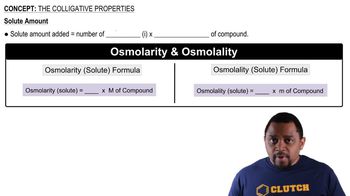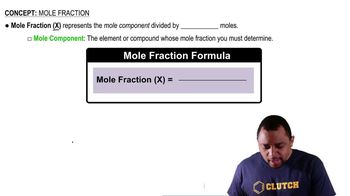This figure shows the interaction of a cation with surrounding water molecules. (b) Which of the following explanations accounts for the fact that the ion–solvent interaction is greater for Li+ than for K+? a. Li+ is of lower mass than K+. b. The ionization energy of Li is higher than that for K. c. Li+ has a smaller ionic radius than K+. d. Li has a lower density than K. e. Li reacts with water more slowly than K. [Section 13.1]
Ch.13 - Properties of Solutions
Chapter 13, Problem 1
A solution contains 0.115 mol H2O and an unknown number of moles of sodium chloride. The vapor pressure of the solution at 30 °C is 25.7 torr. The vapor pressure of pure water at this temperature is 31.8 torr. Calculate the number of grams of sodium chloride in the solution. (Hint: Remember that sodium chloride is a strong electrolyte.)
 Verified step by step guidance
Verified step by step guidance1
Step 1: Use Raoult's Law to determine the mole fraction of water in the solution. Raoult's Law is given by P_solution = X_solvent * P_pure, where P_solution is the vapor pressure of the solution, X_solvent is the mole fraction of the solvent (water), and P_pure is the vapor pressure of pure water.
Step 2: Rearrange Raoult's Law to solve for the mole fraction of water: X_water = P_solution / P_pure. Substitute the given values: P_solution = 25.7 torr and P_pure = 31.8 torr.
Step 3: Calculate the mole fraction of sodium chloride (X_NaCl) in the solution. Since the sum of mole fractions in a solution is 1, use the equation X_water + X_NaCl = 1 to find X_NaCl.
Step 4: Use the mole fraction of sodium chloride to find the number of moles of sodium chloride. The mole fraction is defined as X_NaCl = n_NaCl / (n_NaCl + n_H2O), where n_NaCl is the number of moles of sodium chloride and n_H2O is the number of moles of water (0.115 mol).
Step 5: Solve for n_NaCl and convert it to grams using the molar mass of sodium chloride (NaCl), which is approximately 58.44 g/mol.
Key Concepts
Here are the essential concepts you must grasp in order to answer the question correctly.
Raoult's Law
Raoult's Law states that the vapor pressure of a solvent in a solution is directly proportional to the mole fraction of the solvent. In this case, the presence of sodium chloride lowers the vapor pressure of water, which can be calculated using the difference between the vapor pressures of pure water and the solution.
Recommended video:
Guided course

Raoult's Law and Vapor Pressure
Colligative Properties
Colligative properties are properties of solutions that depend on the number of solute particles in a given amount of solvent, rather than the identity of the solute. Since sodium chloride dissociates into two ions (Na+ and Cl-) in solution, it affects the vapor pressure more significantly than a non-electrolyte would, necessitating the use of the van 't Hoff factor in calculations.
Recommended video:
Guided course

Colligative Properties
Mole Fraction
Mole fraction is a way of expressing the concentration of a component in a mixture, defined as the number of moles of that component divided by the total number of moles of all components. In this problem, calculating the mole fraction of water is essential to apply Raoult's Law and determine the effect of sodium chloride on the vapor pressure of the solution.
Recommended video:
Guided course

Mole Fraction Formula
Related Practice
Textbook Question
Textbook Question
Consider two ionic solids, both composed of singly charged ions, that have different lattice energies. (a) Will the solids have the same solubility in water? (b) If not, which solid will be more soluble in water, the one with the larger lattice energy or the one with the smaller lattice energy? Assume that solute–solvent interactions are the same for both solids. [Section 13.1]
3
views
